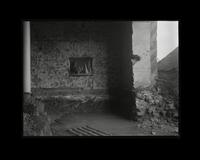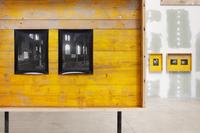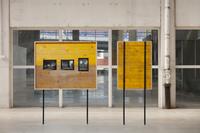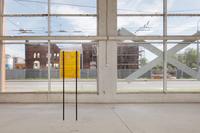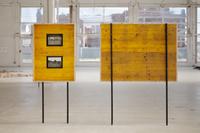Lukáš Jasanský & Martin Polák: A Foreman's Work
A series of photographs capturing the disappearance of the original condition of the former municipal slaughterhouse. Opening of Transformation, the first scene of the exhibition cycle Oh and Hah, Beauty, Ruin and Slack.
PLATO sloughs off its skin. It observes the new body that it will soon enter, as it transforms from a condition called ruin to a new one called gallery, in all the complexity of the metamorphosis of a former slaughterhouse into a cultural institution. PLATO has asked the artistic duo Lukáš Jasanský and Martin Polák to capture this transition phase. Jasanský and Polák metamorphosed into the role of eager artists leaving their footprints on the white surface of the first snow before the building becomes a gallery and before the institutions to which it belongs and which will inhabit it – the City and the Gallery – open their offices there. They are as early as pioneers and as skilled as foremen. They test the proportions, finding out how their photos fit in the new destination. They use the photos, as well as other objects from the site, to measure the walls for the works of artists who will come after them. Oh those walls! The walls that have survived. They have survived different eras and the lives of so many animals that ended within them. They have a memory. Photos do too. They have eyes just as walls have ears.
Yet the two artists remain dreamers who can see the beauty of gallery walls where there isn’t any yet, or the romance of their wild existence. In conditions that are physically hard for art, but institutionally easy, they install their exhibition that the audience – just like PLATO – will be able to see only secondarily. PLATO’s first exhibition in its seat set in stone (actually brick) is still a surprise. The two artists approach it with all responsibility and seriousness, and the chosen technique of its documentation is also serious and refers to a tradition that is well-suited for such a ceremony. And since Jasanský and Polák are not only artists, but also documentary photographers, they document this first exhibition with dignity, using an old wooden camera inherited from their ancestors (photographers may have used the same camera when taking pictures of the slaughterhouse building in the full glory of the industrial boom). In the meantime, though, their exhibition is in preparation in the old cloak of PLATO–Bauhaus where – as artists – they exhibit documentary photographs of this first exhibition in the new location of the gallery that isn’t located there yet. These documentary photographs, presented as a series of black-and-white contact copies from a large-format negative of 18 × 24 cm, have meanwhile become an art project.
So when we are at the exhibition A Foreman’s Work looking at the photographs of an exhibition that has already been held and is a thing of the past, we look at the same time at the near future, with both PLATO bodies, the glass one and the brick one, standing next to us at the same time. We look at the photos in showcases and it feels like seeing Berlin after the bombing. In the photographs, the ruins are often so similar to one another.
How do we perceive new institutions or places for them growing out of the ruins of other institutions from other times? By analogy to these transformations, Jasanský and Polák repeatedly exhibit “documentations” of their exhibitions. They question their authorship and the genre with irony and self-irony, both attributed to them and belonging to them. The exhibition taking as subject the place at the moment of its new institutionalization not only comments on the process of “setting in stone” the up-to-now moveable project of PLATO – a gallery for contemporary art, but also elaborates a situation of strange temporal successions with Jasanský and Polák being the first exhibition colonizers of the new art space, which in fact doesn’t really exist yet. Without any gallery facilities, they install their exhibition for spectators who are not there yet, but can only view it now.
Edith Jeřábková
Lukáš Jasanský and Martin Polák form a photographic tandem that has been operating for more than thirty years, presenting meaningfully formulated conceptual projects at almost regular intervals. The basic means of expression of Lukáš Jasanský and Martin Polák are photographic cycles in which repetition, seriality or the element of an archive are used. The whole is always primary, as individual photographs cannot work properly without its context. Together, they elaborate the subject of the intended cycle, as well as the subsequent taking of photographs, and also the way the series is presented. The ironic distance from the medium of photography and the art world makes their work one of the most consistent subversive long term projects in this country.
←→
Special thanks to the Ministry of Culture of the Czech Republic and Moravian-Silesian Region.
